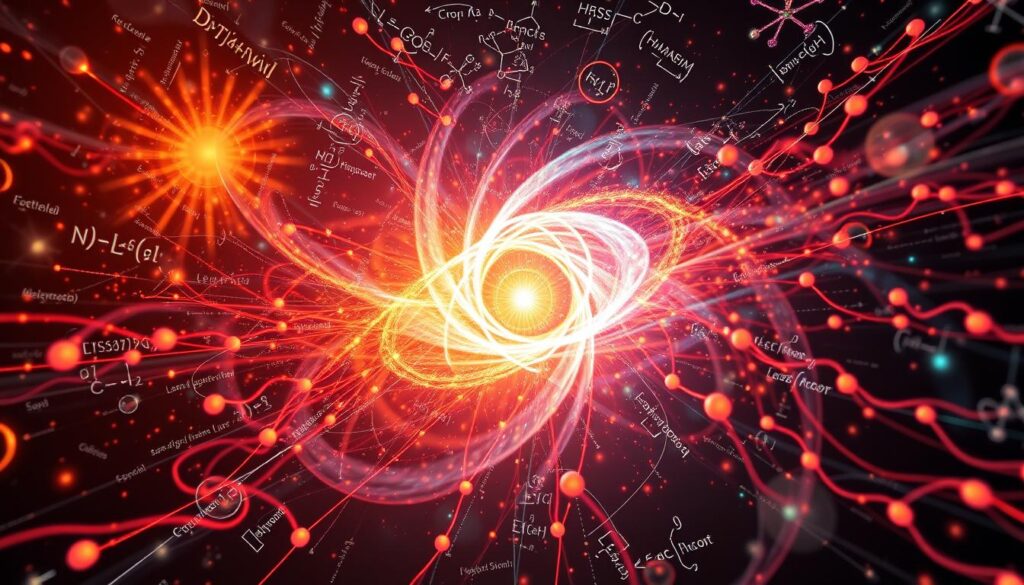
Quantum field theory represents a groundbreaking approach to understanding the fundamental nature of matter and energy. This revolutionary scientific framework bridges quantum mechanics and special relativity, offering unprecedented insights into the subatomic world.
As you explore quantum field theory, you’ll uncover how particles emerge from complex energy interactions. Unlike traditional physics models, this theory reveals that what we perceive as particles are actually dynamic excitations within underlying quantum fields.
Scientists like Richard Feynman and Julian Schwinger transformed our understanding through quantum field theory. Their work demonstrated that fundamental particles are not solid objects but intricate energy manifestations that interact across microscopic landscapes.
Your journey into quantum field theory will challenge traditional perceptions of reality. By examining how energy and matter interconnect at the most profound levels, you’ll gain revolutionary perspectives on the universe’s fundamental mechanisms.
Quantum field theory continues to push scientific boundaries, providing critical insights into particle physics, quantum mechanics, and our deepest comprehension of physical interactions.
Understanding the Foundation of Quantum Field Theory

Quantum field theory represents a groundbreaking approach to understanding the fundamental nature of particles and interactions in physics. This revolutionary framework emerged as a powerful solution to the limitations of traditional quantum mechanics, especially when describing high-energy particle behaviors.
At its core, quantum field theory reimagines particles not as discrete objects but as exciting wave-like disturbances within underlying quantum fields. These fields permeate all of space, creating a dynamic landscape where particle physics comes to life. Instead of viewing particles as isolated entities, quantum field theory sees them as complex manifestations of energy and interactions.
The mathematical elegance of quantum field theory allows scientists to explore particle physics with unprecedented depth. Researchers can now describe how particles are created, destroyed, and transformed through intricate field interactions. This approach provides a comprehensive understanding of subatomic phenomena that classical theories could not explain.
You’ll find that quantum field theory bridges the gap between quantum mechanics and special relativity, offering a more complete picture of the microscopic world. By treating particles as quantum excitations, physicists can model complex interactions with remarkable precision, opening new frontiers in our understanding of fundamental natural processes.
The Evolution of Quantum Electrodynamics

Quantum electrodynamics (QED) represents a groundbreaking scientific theory that revolutionized our understanding of electromagnetic interactions. This powerful quantum field theory emerged as a critical breakthrough in particle physics during the mid-20th century. Pioneering scientists like Richard Feynman, Julian Schwinger, and Sin-Itiro Tomonaga developed quantum electrodynamics to explain how charged particles interact through electromagnetic forces.
The development of quantum electrodynamics solved complex mathematical challenges that classical physics could not resolve. By combining quantum mechanics with special relativity, researchers created a sophisticated framework for understanding subatomic particle interactions. QED provided unprecedented accuracy in predicting electromagnetic phenomena, particularly the behavior of electrons and photons.
Scientists discovered that quantum electrodynamics could predict experimental results with remarkable precision. The theory successfully explained intricate quantum interactions, such as the anomalous magnetic moment of the electron. These predictions have been verified through numerous high-precision experiments, establishing QED as one of the most accurate scientific theories ever developed.
Your understanding of modern physics depends on grasping the fundamental principles of quantum electrodynamics. The theory continues to influence research across multiple scientific disciplines, driving innovation in quantum technologies and fundamental particle physics.
Mathematical Framework Behind Field Theories

Quantum field theory represents a sophisticated mathematical approach to understanding fundamental particle interactions. You’ll discover how complex mathematical tools help scientists describe the behavior of subatomic particles with remarkable precision. The framework relies on advanced mathematical techniques that transform our understanding of particle physics.
At the core of quantum field theory are powerful mathematical concepts like Lagrangians and Hamiltonians. These mathematical structures allow physicists to model particle interactions by defining energy landscapes and momentum transformations. Symmetry principles play a crucial role in developing predictive models that explain quantum mechanical phenomena.
Renormalization emerges as a critical technique for handling mathematical infinities that arise during quantum field theory calculations. By systematically removing problematic infinite values, researchers can extract meaningful physical predictions. This mathematical trick enables scientists to reconcile quantum mechanical predictions with experimental observations.
You’ll find that action principles and perturbation theory provide essential mathematical tools for calculating observable quantities in quantum field theory. These approaches allow physicists to develop sophisticated models that predict particle interactions with unprecedented accuracy.
Understanding the mathematical framework requires deep insight into complex computational techniques. Quantum field theory continues to challenge mathematicians and physicists, pushing the boundaries of our comprehension of fundamental physical processes.
Exploring Gauge Theories in Particle Physics

Gauge theories represent a fundamental approach in particle physics that helps scientists understand how fundamental forces interact at the smallest scales. These remarkable theories provide a mathematical framework for describing the behavior of subatomic particles and their interactions.
In the world of particle physics, gauge theories reveal how symmetries play a crucial role in understanding nature’s fundamental mechanisms. By exploring these theories, researchers can explain complex interactions between elementary particles with remarkable precision. The concept of gauge invariance allows physicists to develop sophisticated models that predict particle behaviors.
Quantum electrodynamics serves as a prime example of a successful gauge theory. This theory explains how electromagnetic forces work between charged particles, demonstrating the power of gauge theories in particle physics. Scientists use these mathematical tools to map out intricate relationships between different particles and their interactions.
Gauge theories have become essential in modern physics, helping researchers develop a deeper understanding of fundamental forces. They provide insights into quantum mechanics and help explain phenomena that classical physics cannot describe. By studying these theories, you can glimpse the intricate mechanisms that govern the universe at its most fundamental level.
From the electroweak theory to quantum chromodynamics, gauge theories continue to push the boundaries of our understanding of particle physics. They offer a powerful lens through which scientists can explore the complex world of subatomic interactions.
Quantum Chromodynamics and Strong Interactions

Quantum chromodynamics is a fascinating branch of particle physics that explores the fundamental interactions between quarks and gluons. Unlike electromagnetic forces, quantum chromodynamics describes the strong nuclear force that binds subatomic particles together. You’ll discover how this complex theory explains the behavior of particles at the smallest scales of existence.
At the heart of quantum chromodynamics lies the concept of color charge. This unique property is different from electric charge and determines how quarks interact. Quarks carry one of three color charges: red, green, or blue. Gluons mediate these interactions, transmitting color charges between quarks and creating incredibly strong binding forces within atomic nuclei.
The theory reveals two remarkable properties of quantum chromodynamics: asymptotic freedom and confinement. At extremely high energies, quarks move almost freely, while at lower energies, they remain tightly bound within hadrons. This explains why you cannot observe individual quarks in isolation, making quantum chromodynamics a crucial framework for understanding nuclear physics.
Scientists use quantum chromodynamics to model complex interactions in particle accelerators and explore the fundamental structure of matter. By studying these intricate quantum interactions, researchers continue to unlock the mysteries of the subatomic world, pushing the boundaries of our understanding of fundamental physics.
The Standard Model: A Unified Framework
The standard model represents a groundbreaking framework in particle physics that explains the fundamental building blocks of our universe. This powerful theoretical model describes how subatomic particles interact and provides scientists with an unprecedented understanding of matter’s smallest components.
At its core, the standard model classifies elementary particles into two primary categories: quarks and leptons. These particles form the foundation of all known matter in the universe. Quarks combine to create protons and neutrons, while leptons include familiar particles like electrons and neutrinos.
Your exploration of the standard model reveals three fundamental forces: electromagnetic, weak, and strong interactions. These forces govern how particles communicate and transform. The model’s most significant triumph came with the discovery of the Higgs boson in 2012, which confirmed predictions about how particles acquire mass.
Despite its remarkable predictive power, the standard model isn’t complete. It doesn’t explain gravity or dark matter, leaving physicists eager to explore beyond its current boundaries. Researchers continue refining this theoretical framework, pushing the limits of our understanding of fundamental particle interactions.
By providing a comprehensive view of subatomic interactions, the standard model remains one of the most successful scientific theories in human history. It bridges quantum mechanics and particle physics, offering profound insights into the universe’s intricate workings.
Feynman Diagrams: Visualizing Quantum Interactions
Feynman diagrams offer a revolutionary way to understand complex quantum interactions. These graphical tools help physicists map out particle behaviors in ways traditional mathematics cannot easily describe. By using simple lines and vertices, these diagrams translate intricate quantum mechanical processes into visual representations.
When you explore feynman diagrams, you’ll discover they act like a universal language for particle physics. Each diagram represents specific quantum interactions, showing how particles move, exchange energy, and transform. Researchers use these diagrams to calculate probabilities of different quantum events, breaking down complicated interactions into manageable steps.
The power of feynman diagrams lies in their ability to simplify extremely complex quantum scenarios. Physicists can quickly sketch out potential particle interactions, predict outcomes, and understand energy exchanges. From elementary particle collisions to advanced quantum field theory calculations, these diagrams provide an intuitive pathway to understanding microscopic world dynamics.
Learning to read feynman diagrams requires practice, but the visual approach makes quantum mechanics more accessible. Each line represents a particle’s path, while vertices show interaction points. By studying these graphical tools, you can gain insights into how subatomic particles behave and interact at the most fundamental levels of reality.
Renormalization: Handling Infinities
Quantum field theory presents a fascinating challenge when mathematical calculations produce infinite values. Renormalization emerges as a powerful technique to address these problematic infinite results. This sophisticated method allows physicists to extract meaningful physical predictions from seemingly impossible calculations.
When diving into renormalization, you’ll discover it’s more than just a mathematical trick. Scientists use this approach to remove unwanted infinities that appear in quantum field theory calculations. The process involves carefully rescaling physical parameters to eliminate divergent terms while preserving the essential physics of the system.
Renormalization group methods provide deeper insights into how physical systems behave across different energy scales. Researchers apply these techniques across multiple domains, from particle physics to condensed matter research. By understanding how interactions change with energy, scientists can make more accurate predictions about complex quantum systems.
The beauty of renormalization lies in its ability to transform seemingly intractable mathematical problems into workable solutions. It allows physicists to bridge the gap between microscopic quantum interactions and macroscopic observable phenomena. Understanding this technique opens up new perspectives on how fundamental particles interact and evolve.
As you explore renormalization, you’ll appreciate its crucial role in modern theoretical physics. It represents a sophisticated approach to understanding the quantum world, revealing the elegant mathematical structures that underpin our understanding of nature’s most fundamental processes.
Applications in Modern Physics and Technology
Quantum field theory has revolutionized our understanding of modern physics and technology. You’ll discover how this powerful framework extends far beyond traditional particle physics, transforming multiple scientific disciplines and technological innovations.
In condensed matter physics, quantum field theory helps researchers explain complex phenomena like superconductivity. Scientists use these advanced theoretical models to understand how materials behave at microscopic levels, enabling breakthroughs in electronics and materials science.
Quantum computing represents another exciting frontier for quantum field theory applications. Advanced quantum algorithms leverage quantum field theory principles to solve complex computational problems that classical computers cannot handle. Your understanding of these intricate interactions opens doors to unprecedented computational capabilities.
Cosmological research relies heavily on quantum field theory to explore the universe’s earliest moments. Researchers use these sophisticated theoretical frameworks to investigate quantum fluctuations that potentially triggered cosmic expansion, revealing fundamental insights about our universe’s origin and structure.
Quantum entanglement, a fascinating quantum field theory concept, continues to drive innovations in communication and cryptography. By understanding how subatomic particles interact, scientists develop secure communication technologies that could transform global information exchange.
Quantum Gravity: The Next Frontier
The search for quantum gravity represents one of the most exciting challenges in modern physics. You are entering a realm where scientists strive to bridge the gap between quantum mechanics and general relativity. This quest seeks to understand how gravity behaves at the smallest scales of the universe.
Researchers are exploring multiple approaches to quantum gravity. String theory suggests that fundamental particles are actually tiny vibrating strings of energy. Loop quantum gravity proposes that space itself is composed of discrete quantum units. These innovative frameworks aim to resolve long-standing paradoxes in our understanding of physical reality.
Anti-de sitter space plays a crucial role in theoretical investigations. This mathematical model provides unique insights into quantum gravity by creating a framework where quantum field theory and gravitational interactions can be studied together. Scientists use advanced mathematical techniques to probe the complex relationships between quantum mechanics and gravitational phenomena.
The ultimate goal of quantum gravity research is to develop a comprehensive theory that explains how fundamental forces interact at the smallest possible scales. Your understanding of this cutting-edge field can help appreciate the profound mysteries that continue to challenge scientific comprehension.
Conclusion
Quantum field theory represents a groundbreaking approach to understanding the fundamental nature of our universe. Your journey through this complex scientific framework reveals how physicists have developed sophisticated tools to explore the intricate interactions of subatomic particles. The quantum field theory provides a comprehensive lens for examining the most fundamental building blocks of reality.
As you reflect on the concepts explored, it becomes clear that quantum field theory is not just a theoretical construct but a powerful method for decoding the universe’s deepest mysteries. Researchers continue to push the boundaries of this field, exploring connections between quantum mechanics, particle physics, and our understanding of fundamental forces. Each breakthrough brings us closer to unraveling the complex tapestry of physical interactions.
The future of quantum field theory looks incredibly promising. From potential technological innovations to deeper insights into cosmic phenomena, this scientific approach continues to challenge our traditional understanding of physical reality. You are witnessing a dynamic field of research that promises to unlock new dimensions of knowledge about the fundamental structures that compose our world.
Your exploration of quantum field theory demonstrates the incredible potential of human curiosity and scientific inquiry. While many questions remain unanswered, the ongoing research continues to inspire physicists and researchers worldwide to probe deeper into the quantum realm, seeking to understand the intricate mechanisms that govern our universe.



